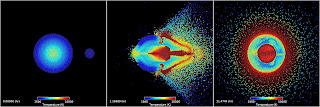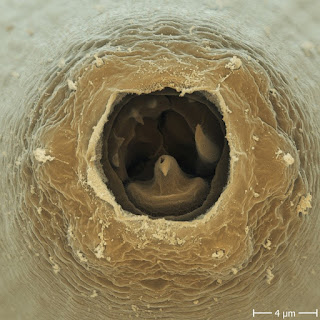Floppy or not: AI predicts properties of complex metamaterials
Nov 2022, phys.org
With infinite options, infinite intelligence?
Also words:
Artificial materials - These are engineered materials whose properties are determined by their geometrical structure rather than their chemical composition [like origami].
I must have missed the part when we started calling them artificial materials, I thought they were all metamaterials.
Designing these materials is a combinatorial problem, which means it's hard. You can't really predict what will happen, you just have to do it. But artificial intelligence can do it virtually, all day, and find the ones that work.
via University of Amsterdam: Ryan van Mastrigt et al, Machine Learning of Implicit Combinatorial Rules in Mechanical Metamaterials, Physical Review Letters (2022). DOI: 10.1103/PhysRevLett.129.198003
Clear window coating could cool buildings without using energy
Nov 2022, phys.org
A "transparent radiative cooler" could lower the temperature inside buildings, without expending a single watt of energy.
The team constructed computer models of TRCs consisting of alternating thin layers of common materials like silicon dioxide, silicon nitride, aluminum oxide or titanium dioxide on a glass base, topped with a film of polydimethylsiloxane. They optimized the type, order and combination of layers using an iterative approach guided by machine learning and quantum computing, which stores data using subatomic particles.
Cooling accounts for about 15% of global energy consumption; this thing can potentially reduce cooling energy consumption by 31% compared with conventional windows.
via Notre Dame: High-Performance Transparent Radiative Cooler Designed by Quantum Computing, ACS Energy Letters (2022). DOI: 10.1021/acsenergylett.2c01969
Photovoltaic windows unlock goal of increased energy efficiency for skyscrapers
Nov 2022, phys.org
Energy use climbs when a building has more windows than wall space, yet larger floor-to-floor height coupled with PV glazing reduces building energy use.
via National Renewable Energy Laboratory: Vincent M. Wheeler et al, Photovoltaic windows cut energy use and CO2 emissions by 40% in highly glazed buildings, One Earth (2022). DOI: 10.1016/j.oneear.2022.10.014
New study suggests mobile data collected while traveling over bridges could help evaluate their integrity
Nov 2022, phys.org
I can see a future where we intercept wifi signals from building occupants, and measure their interactions to determine not only the building materials getting hit by the wifi waves, but their changes over time:
"Information about structural health of bridges can be extracted from smartphone-collected accelerometer data"
via MIT: Thomas Matarazzo, Crowdsourcing bridge dynamic monitoring with smartphone vehicle trips, Communications Engineering (2022). DOI: 10.1038/s44172-022-00025-4.
Centimeter-scale multicolor printing with a pixelated optical cavity
Nov 2022, phys.org
"pixelated optical cavity"
The colorful image with multiple color components is first converted to a predefined grayscale pattern and then engraved on the photoresist layer by controlling the exposure dose during the grayscale laser writing process.
Pixelated photoresist spacer layers are sandwiched by two semitransparent sliver thin films to form the Fabry–Perot cavities (pixelated optical cavities). The transmission color can be continuously tuned in the visible spectral regime by finely controlling the thickness of the photoresist layer.
via Southern University of Science and Technology in Shenzhen: Yu Chen et al, Centimeter scale color printing with grayscale lithography, Advanced Photonics Nexus (2022). DOI: 10.1117/1.APN.1.2.026002
Team creates crystals that generate electricity from heat
Nov 2022, phys.org
This novel synthetic material is composed of copper, manganese, germanium, and sulfur, and it is produced by simple ball-milling and then heating to 600 degrees Celsius.
It's called a "thermoelectric material" because it converts heat to electricity.
via Normandie University: V. Pavan Kumar et al, Engineering Transport Properties in Interconnected Enargite‐Stannite Type Cu 2+ x Mn 1− x GeS 4 Nanocomposites, Angewandte Chemie International Edition (2022). DOI: 10.1002/anie.202210600
Mimicking life: A breakthrough in non-living materials
Nov 2022, phys.org
Artificial Life - Ok they're calling them all kinds of things, now including "non-living materials", also related to soft robotics:
New process that uses fuel to control non-living materials at a specified rate, similar to what living cells do
"Ultimately you'd want a robot to be able to control itself. You can program our cycle into a particle in advance, then leave it alone, and it performs its function independently as soon as it encounters a signal to do so."
Particles man.
via Delft University of Technology: Benjamin Klemm et al, Temporally programmed polymer—solvent interactions using a chemical reaction network, Nature Communications (2022). DOI: 10.1038/s41467-022-33810-y
Discovery reveals 'brain-like computing' at molecular level is possible
Nov 2022, phys.org
Brains all the way down:
"Intelligent molecular materials"
Disruptive new alternative to conventional silicon-based digital switches that can only ever be either on or off. It displays all the mathematical logic functions necessary for deep learning.
"The community has long known that silicon technology works completely differently to how our brains work and so we used new types of electronic materials based on soft molecules to emulate brain-like computing networks."
via University of Limerick's Bernal Institute: Enrique del Barco, Dynamic molecular switches with hysteretic negative differential conductance emulating synaptic behaviour, Nature Materials (2022). DOI: 10.1038/s41563-022-01402-2
Self-assembled nanoscale architectures could feature improved electronic, optical, and mechanical properties
Nov 2022, phys.org
Internet of Everything
"Self-assembly is a really beautiful way to make structures," Yager said. "You design the molecules, and the molecules spontaneously organize into the desired structure."
via Department of Energy's Brookhaven National Laboratory's Center for Functional Nanomaterials: Sebastian T. Russell et al, Priming self-assembly pathways by stacking block copolymers, Nature Communications (2022). DOI: 10.1038/s41467-022-34729-0
Breakthrough algorithm expands the exploration space for materials by orders of magnitude
Nov 2022, phys.org
Algorithm that predicts the structure and dynamic properties of any material—whether existing or new—almost instantaneously.
It's called M3GNet and it was used to develop
matterverse.ai, a database of more than 31 million yet-to-be-synthesized materials with properties predicted by machine learning algorithms.
via University of California San Diego: Chi Chen, A universal graph deep learning interatomic potential for the periodic table, Nature Computational Science (2022). DOI: 10.1038/s43588-022-00349-3
Kirigami technique hints at promising outcomes for breast reconstruction
Dec 2022, phys.org
Kirigami boobs
via University of Pennsylvania: Young‐Joo Lee et al, Natural Shaping of Acellular Dermal Matrices for Implant‐Based Breast Reconstruction via Expansile Kirigami, Advanced Materials (2022). DOI: 10.1002/adma.202208088




















